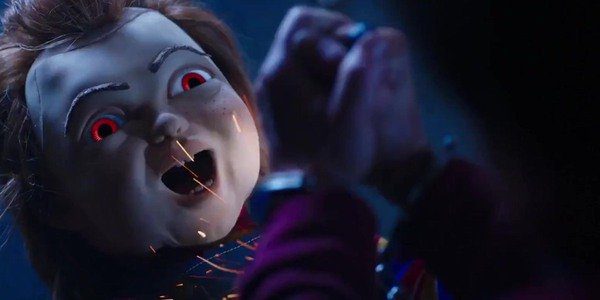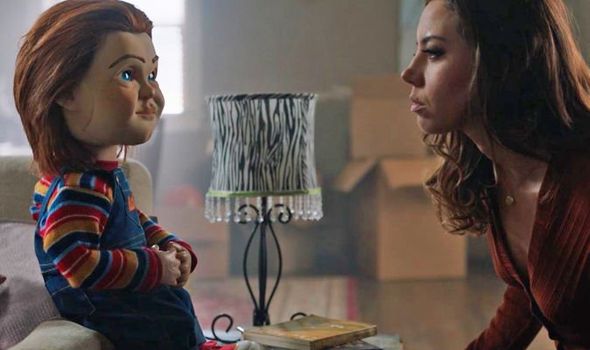“Are we having fun now?”
The only thing more predictable than comic book movies these days are reboots. Hell, there’s a new Texas Chainsaw Massacre coming to Netflix soon, which will make the ninth installment of a franchise that really boasts only one great movie, a movie that is fifty damn years old. So even though the first Child’s Play wasn’t great (although it’s a lot of fun), a reboot was inevitable. Lars Klevberg’s remake isn’t great, but neither was the original. Who cares? Does it matter? Why am I doing this?
What this Child’s Play lacks that the original had is an absolute bananas opening (remember, Brad Dourif played a serial killer who used a voodoo incantation to implant his soul in a doll). We’re introduced to the line of Buddi dolls, which can help you go about your day, run the house, and learn your routines. Think a bipedal Alexa. It’s the hot-ticket item of this toy season (oddly enough, not Christmas). Unfortunately, Andy ends up with one that had the safety protocols disabled by a disgruntled factory worker. It doesn’t have the “holy shit” factor of the original, but it’s a good enough way to get things going.
Karen (Aubrey Plaza) is scraping by, working doubles so she can get Andy a new hearing aid. When someone returns the defective Buddi, Karen cajoles her boss into letting her take it home. Andy is nonplussed by the gift – to the film’s credit, it doesn’t pretend that the Buddi dolls aren’t creepy – but Karen endearingly convinces him to try it out. “I know it’s dumb,” she says, “but let’s give it a shot.”
Plaza is good in the role, and seems to actually be taking this seriously. With Plaza it’s always a toss-up; you can’t tell me she actually thought voicing Grumpy Cat was a worthwhile use of her time. She often seems like she’s above whatever project she’s in (apart from maybe Legion), so it’s nice to see her giving a solid performance. It helps that she has great chemistry with Gabriel Bateman, the actor playing her son. It lets Plaza come off as believable and sympathetic; beyond that, Bateman is terrific in the role. He’s the real star of the movie, and thank god, because there are some child performers here who are…let’s say, less suited to their roles.
Andy names the doll Chucky – well, he names it Han Solo, and the doll names itself Chucky for some reason – and their relationship develops pretty much as you’d expect. There’s something strangely touching about their growing affection for each other. Bateman does a killer job playing a lonely boy who doesn’t know how to make friends until friends stumble into his life. Those would be Falyn (Beatrice Kitsos) and Pugg (Ty Consiglio). Kitsos is good, Consiglio tragically over the top. Andy also befriends Mike, a detective living on his floor. Mike is played by Brian Tyree Henry, an always welcome presence whose deadpan delivery is just terrific.
Eventually, of course, Chucky begins killing, not out of any homicidal rage, but out of a fierce protectiveness of Andy (this version of Chucky acts a lot like the evil Krusty doll from The Simpsons: “There’s your problem, someone set this thing to evil”). First to go is the family cat, and next on the chopping block is Karen’s boyfriend, Shane. Shane is probably the film’s largest stumbling block; he’s not only rude to Andy, but actively threatens him. That Karen does nothing to intervene undermines the film’s presentation of her as a good mother. It doesn’t help that David Lewis gives Shane zero dimensionality. He’s just awful on the surface and all the way through. I personally hate when movies do this, but it does give us a fun scene which ends with Shane wrapped in Christmas lights, legs broken in a watermelon patch, and his face shorn clean off by a rototiller. This makes sense in context – kind of.
Until its gonzo finale, Child’s Play has a strangely low body count. Only a few of these are of any merit; there’s Doreen, Mike’s saintly mother, and Gabe, the building’s pervy maintenance guy, who has cameras set up to watch Karen shower. Child’s Play doesn’t really believe in characterization of its side characters: you’re either perfect or rotten. At least Mark Hamill does a great job voicing Chucky; even the original film’s director, who wanted nothing to do with this version, admitted that the casting was perfect. Hamill injects real pathos into Chucky’s pleas for friendship. He sounds genuinely heartbroken when Andy rejects him, and believably vengeful when killing Gabe. The doll itself is pretty impressive, too. It’s not CGI, as you’d expect, but a robot/puppet hybrid that always seems to be crawling its way out of the uncanny valley.
The climax is the film’s brightest point. Child’s Play fails as a satire of capitalism, but it knows when to go to horror-movie extremes. There’s some of Five Nights at Freddy’s here, and dash of Stephen King’s “Battleground.” There’s tension and stakes, and Henry and Plaza both get some great moments. It’s the most coherent part of the film, which sounds like damning with faint praise, so let’s say it’s the part of the film that feels the best planned-out. It’s certainly the part of the film that feels like it replicates the crazy fun of the original. It’s possible to remake a mediocre movie and turn it into a masterpiece (which is what happened with The Fly and The Thing), but this isn’t that. Ultimately, Child’s Play is mostly just fine, but what more can you expect from it?



